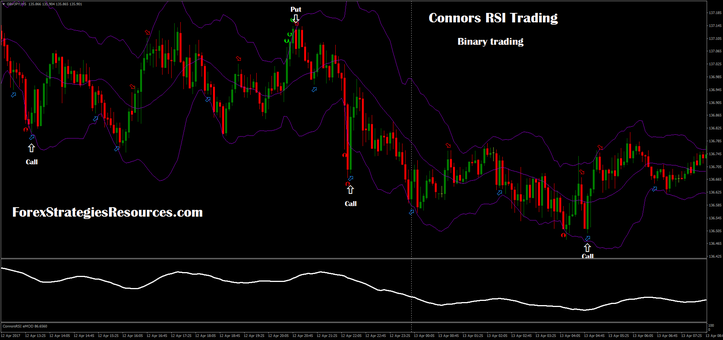Connors rsi trading strategy
Developed by Larry Connors and Dave Landry, this strategy looks for overextended VIX readings to signal excessive fear or greed in the stock market.
Excessive fear is used to generate buy signals in this mean-reversion strategy, while excessive greed is used to generate sell signals. Volatility is a measure of risk.
Stochastic RSI - Technical Analysis
Relatively high volatility reflects higher risk in the stock market. Relatively low volatility suggests low risk. The VIX is also known as the fear index. Volatility and the VIX spike when fear hits the stock market. This causes a surge in implied volatility for put options, which means put prices also surge. Complacency is the opposite of fear. The VIX moves lower as fear subsides and traders are deemed complacent when the VIX reaches excessively low levels.
This article will list the rules in the first sentence and then provide a methodology based on SharpCharts. The daily low is above its day moving average. This means the entire bar or candlestick must be above the day moving average. The Percent Price Oscillator PPO can be used to define rule two, but this means using a day exponential moving average. PPO 1,10,1 shows the percentage difference between the 1-day EMA close and the day EMA.
The close is below the open. This rule is a modification from Dave Landry. It simply means that the candlestick must be black or filled. A filled candlestick indicates that the close is below the open. A white or hollow candlestick indicates the close is above the open. Getting all three rules to align on the same day doesn't happen as often as one would think. The green arrows highlight four buy signals from late July to late September This would increase the number of signals.
The high of the VIX is below the day moving average. This means the entire bar or candlestick must be below the day moving average. Again, chartists can use the Percent Price Oscillator 1,10,1 to measure this. A value of means the close is 10 percent below the day EMA.

The close is above the open. This modification from Dave Landry means that the candlestick must be white or hollow.
The example below shows one sell signal in the second half of The PPO 1,10,1 moved below several times and there were a few white candlesticks below the day moving average, but the three rules only aligned once.
Again, relaxing these rules by creating a rule window 3 days would increase signal frequency. Connors and Landry suggested relatively tight stop-losses. On long positions, a stop-loss would be triggered when the VIX moves below the prior day's day moving average on an intraday basis. Short positions would be closed when the VIX moves above the prior day's day moving average. Alternatively, Connors and Landry suggest that traders could exit within two rbi rupee dollar exchange rate four days.
This makes the system quite short-term oriented. This article is not designed to promote a single trading strategy right out of the box. Instead, it is designed to show a trading strategy developed by a professional. Larry Connors and David Landry designed this strategy to suit their trading preferences, which might not fit yours. Chartists should learn from the methodology, apply some tweaks and develop a strategy that suits their trading style.
The Connors rsi trading strategy strategy uses the VIX exclusively, which means it is an excellent means to complement other strategies for trading the major indices. For example, chartists could lengthen the look-back periods for moving averages and the Percent Price Oscillator PPO to make this a more medium-term oriented strategy. Chartists could also look at alternatives using weekly charts.
Also note that the Chicago Board Options Exchange CBOE calculates volatility indices for a number of different ETFs and indices.
These include the Gold SPDR, the US Oil Fund, the Euro Currency Trust, the Dow Industrials and the Nasdaq Chartists can use these indices to develop trading strategies for the Dow, Nasdaqoil, gold and the Euro. The CVR3 strategy is a classic mean-reversion strategy that takes advantage of overextended conditions.
The VIX is used to measure excessive fear and complacency. Once overextended, a reversion to the mean is expected as prices settle back down. Similarly, CVR3 sell signals should be matched with bearish indications on the price chart. Keep in mind that this article is designed as a starting point for trading system development.
Use these ideas to augment your trading style, risk-reward preferences and personal judgments.
RSI2 [ChartSchool]
From the creator of the CVR3 strategy, this book details more trading strategies and includes a chapter on exits. Connors also shows the details of his back-tests and provides guidelines to improve trading results. Send us your Feedback! Market data provided by: Commodity and historical index data provided by: Unless otherwise indicated, all data is delayed by 20 minutes.
CVR3 VIX Market Timing [ChartSchool]
The information provided by StockCharts. Trading and investing in financial markets involves risk. You are responsible for your own investment decisions.
Testing The RSI 2 Trading Strategy
Log In Sign Up Help. Free Charts ChartSchool Blogs Webinars Members. CVR3 VIX Market Timing.

Table of Contents CVR3 VIX Market Timing. Short Term Trading Strategies that Work Larry Connors and Cesar Alvarez.
Sign up for our FREE twice-monthly ChartWatchers Newsletter! Blogs Art's Charts ChartWatchers DecisionPoint Don't Ignore This Chart The Canadian Technician The Traders Journal Trading Places. More Resources FAQ Support Center Webinars The StockCharts Store Members Site Map.
Terms of Service Privacy Statement.